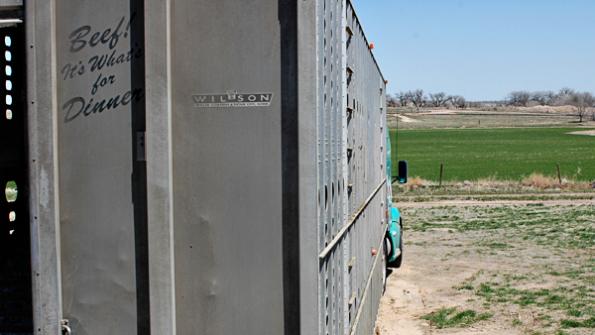Seasonal pressure, including increasing market volume, drove a wider gap in calf prices this week.
October 21, 2017

Narrow, uncertain cattle futures and the increasing number of calves coming to town pressured calf prices this week.
Steers and heifers sold from $4 per cwt lower to $4 higher, according to the Agricultural Marketing Service (AMS). Day to day and region to region, the gaps seemed even wider.
“The market was under pressure this week due to the sheer volume of cattle being offered for sale across the region,” said the AMS reporter on hand for the black hided calf sale at Ft. Pierre Livestock Auction in South Dakota on Wednesday where 4,890 head were on offer.
Nationwide, there were 25.1% more calves and feeder cattle (72,300 head more) trading hands week to week, according to AMS. That included 19.9% (50,700 head) more at auction.
Feeder Cattle futures closed an average of $1.31 lower week to week on Friday (42¢ to $1.92 lower).
For year-to-year context, based on weekly AMS data, feeder steer prices in the North Central region were 27-32% higher at 600-900 pounds; keeping in mind the collapse last fall. Prices were 27-35% higher in the South Central region at 500-800 pounds. In the Southeast, prices were also 27-35% higher, but at 400-700 pounds.
“Cow and calf prices remain unseasonably strong as the market moves through the second half of October,” says Andrew P. Griffith, agricultural economist at the University of Tennessee, in his weekly market comments. “The strength in the market has largely been due to strong demand through the entire cattle complex. Feeder cattle futures have traded fairly steady the last four weeks, which has continued to support calf prices. Generally, feeder cattle futures soften through October and November, which puts downward pressure on calf prices.”
For those planning on wheat pasture, the delay continues with winter wheat planting lagging behind the average pace. According to the most recent USDA Crop Progress report, 60% of winter wheat is planted, which is 10% less than last year and 11% less than average. Only 42% is planted in Kansas compared to 75% for average. In Oklahoma, 57% is planted, 19% behind the average pace. Planting in Texas is 3% ahead of the average pace at 66%.
Fed cattle trudge to steady money
Cattle feeders and packers finally met in the middle on Friday with negotiated fed cattle prices steady with the previous week in the Southern Plains and Nebraska. Prices were $111 per cwt on a live basis in the Southern Plains; $175 dressed in Nebraska. Earlier in the week there was some trade in the Texas Panhandle at $110. Though too few to trend, prices in other regions through Friday afternoon also appeared in the steady range.
Except for $1.15 lower in soon-spent spot October and 20¢ higher in Feb, Live Cattle futures closed an average of 48¢ lower.
Wholesale beef values edged higher for the second consecutive week. Choice boxed beef cutout value was $1.64 higher week to week on Friday at $199.86 per cwt. Select was $1.09 higher at $191.14.
“On the Choice side, the rib and loin primals had the highest gains while the chuck and round primals were steady to weak,” according to AMS analysts.
Based on the monthly slaughter report, AMS analysts note the average dressed weight for a steer in September was 896 pounds, which was 12 pounds heavier than the previous month but 9 pounds lighter than the same month a year ago.
The average dressed weight for a heifer in September was 819 pounds, which was 13 pounds heavier than in August but 5 pounds lighter than a year earlier.
Feedlot placements higher than most estimates
There’s no surprise that the monthly Cattle on Feed report from USDA on Friday shows more cattle placed and on feed. However, markets may view the year-to-year increase as bearish.
Feedlot placements in September of 2.15 million head were 13.5% more than last year. That’s significantly higher—at least 6% more—than most pre-report estimates.
In terms of weights placed, 34.7% weighed 699 pounds or lighter, 46.7% weighed 700-899 pounds and 18.6% went on feed weighing 900 pounds or heavier.
Marketings in September of 1.78 million head were 2.9% more, which was in line with estimates.
Total cattle on feed Oct. 1 of 10.81 million head were 5.4% more, which mirrored estimates ahead of the report. There were 13% more heifers and heifer calves in the on-feed mix than a year earlier.
“Despite the sizable number of cattle outside feedlots, medium-frame feeder steers in Oklahoma City averaged $148.12 per cwt in the third quarter, which is $7.48 higher than the same period last year,” according to analysts with USDA’s Economic Research Service (ERS), in the monthly Livestock, Dairy and Poultry Outlook released on Wednesday. “Winter grazing opportunities in the Southern Plains are likely encouraging increased demand by stockers, which should support feeder calf prices. Fourth-quarter prices are raised from last month to $143-$147per cwt, reflecting firm demand by both backgrounders and feedlots. First-half 2018 prices are raised from last month as well.”
On the other side of the trade, ERS analysts note that increasing cattle numbers are keeping fed cattle prices near year-ago levels.
“Recent large supplies of market-ready cattle have prevented the USDA Five Area fed steer price from rebounding off recent lows,” say ERS analysts. “In July, the monthly weighted average price for fed steers was $118.45 per cwt and trended lower through September to $107.11/cwt. for a quarterly average of $112.46 per cwt. The third-quarter estimate is slightly below prices last year, but the latest weekly price of $109.45 per cwt (Oct. 6) is about 8% higher than the same week last year. As a result, the fourth-quarter fed steer price is unchanged from last month at $108-$112 per cwt, staying above 2016 for the quarter.”
About the Author(s)
You May Also Like



.png?width=300&auto=webp&quality=80&disable=upscale)
.png?width=300&auto=webp&quality=80&disable=upscale)
